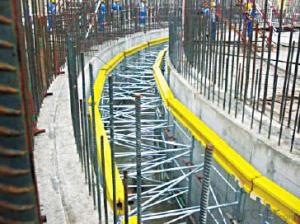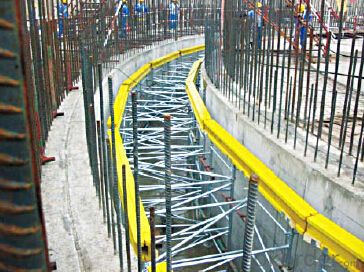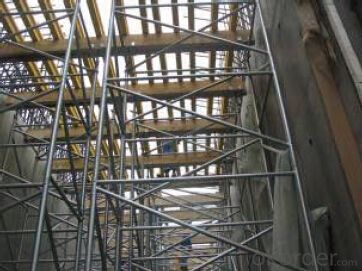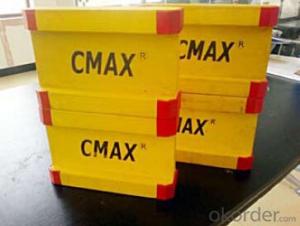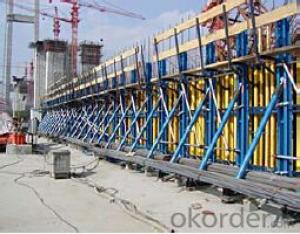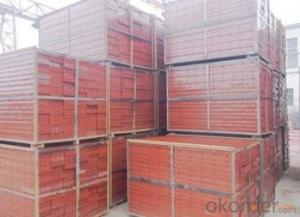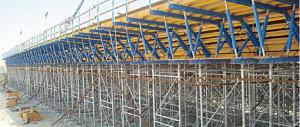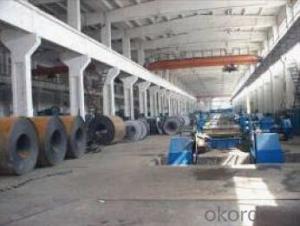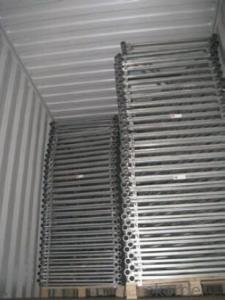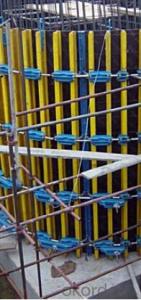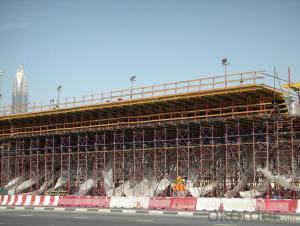Tower Scaffolding System and Formwork System
- Loading Port:
- Tianjin
- Payment Terms:
- TT OR LC
- Min Order Qty:
- 50 m²
- Supply Capability:
- 1000 m²/month
OKorder Service Pledge
Quality Product, Order Online Tracking, Timely Delivery
OKorder Financial Service
Credit Rating, Credit Services, Credit Purchasing
You Might Also Like
Tower Scaffolding
Shoring tower is an effective supporting system. It is easy to assemble and dismantlement, and
has excellent stability and bearing capacity. It has been widely used in the construction of industry
& residential buildings , bridges, tunnels and dam project, etc.
Characteristics:
◆ High degree of standardization.
◆ Easy storage and transportation
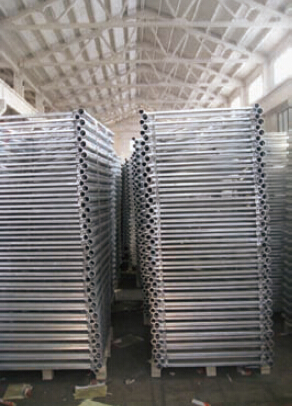
- Q: Can steel formwork be used for bridge construction projects?
- Yes, steel formwork can be used for bridge construction projects. Steel formwork offers high strength and durability, making it suitable for withstanding the heavy loads and harsh environmental conditions typically encountered in bridge construction. Additionally, steel formwork provides excellent dimensional accuracy, ensuring precise and consistent bridge construction.
- Q: How does steel formwork affect the overall sound insulation of the structure?
- Steel formwork does not directly affect the overall sound insulation of the structure since its primary purpose is to provide support during the construction process. However, the use of steel formwork may indirectly impact sound insulation if it affects the placement or installation of soundproofing materials or if it introduces gaps or discontinuities in the structure that can potentially compromise sound insulation.
- Q: What are the different types of finishes available for steel formwork panels?
- The different types of finishes available for steel formwork panels include galvanized, painted, and powder-coated finishes. Galvanized finishes provide corrosion resistance by applying a layer of zinc on the surface of the steel. Painted finishes add color and protection to the panels, while powder-coated finishes offer a durable and aesthetically pleasing coating that is resistant to chipping, scratching, and fading.
- Q: How does steel formwork contribute to the overall sustainability of a construction project?
- Steel formwork contributes to the overall sustainability of a construction project in several ways. Firstly, steel formwork is reusable, which reduces the consumption of raw materials and reduces waste generation. This not only lowers the project's environmental impact but also saves costs in the long run. Secondly, steel formwork provides a durable and robust solution, ensuring a longer lifespan and reducing the need for frequent replacements. Additionally, steel formwork is highly versatile and can be easily adjusted and modified to accommodate various design changes, reducing the amount of material waste. Lastly, steel formwork allows for efficient and faster construction, reducing the project's energy consumption and minimizing disruption to the surrounding environment.
- Q: How does steel formwork affect the overall stability of a structure?
- Steel formwork has a significant impact on the overall stability of a structure. Formwork refers to the temporary molds or frameworks used to shape and support wet concrete until it hardens and becomes self-supporting. Steel formwork, in particular, offers several advantages that positively influence the stability and strength of the structure. Firstly, steel formwork provides exceptional strength and durability compared to other materials like wood or plastic. This high strength allows steel formwork to withstand the pressure exerted by the wet concrete without deformation or collapse. Consequently, the structure's stability is enhanced as the formwork maintains its shape and rigidity during the concrete pouring and curing process. Moreover, steel formwork offers better dimensional accuracy and consistency. Its rigidity prevents any movement or shifting, ensuring that the concrete is poured and cured in the desired shape and dimensions. This precision is crucial for maintaining the structural integrity and stability of the final construction. Additionally, steel formwork allows for greater flexibility in design and construction. It can be easily customized and shaped to meet the specific requirements of the structure, enabling architects and engineers to create complex and unique designs. This flexibility enhances the overall stability of the structure by allowing for efficient load distribution and reinforcement placement. Furthermore, steel formwork possesses excellent load-bearing capacity. It can efficiently distribute the weight of the wet concrete, as well as any additional loads applied during construction, such as workers, equipment, or construction materials. This load-bearing capacity ensures that the structure remains stable and can withstand the imposed loads without compromising its integrity. Lastly, steel formwork has a longer lifespan compared to other formwork materials. Its durability and resistance to deterioration increase the overall stability of the structure over time. Steel formwork can be reused multiple times, reducing waste and costs while maintaining the desired stability and quality of the finished construction. In conclusion, steel formwork significantly contributes to the overall stability of a structure. Its strength, dimensional accuracy, flexibility, load-bearing capacity, and longevity ensure that the formwork maintains its shape and rigidity, supporting the wet concrete and allowing it to cure properly. By providing a solid and reliable foundation, steel formwork enhances the stability and strength of the structure, ensuring its long-term durability.
- Q: How does steel formwork handle different concrete reinforcement types?
- Steel formwork is an excellent choice for dealing with various types of concrete reinforcement due to its versatility and durability. It is commonly used in construction projects to create temporary molds or structures that hold concrete in place during the pouring and curing process. One of the benefits of steel formwork is its ability to handle different types of concrete reinforcement. Whether it's traditional reinforcement like steel bars or modern techniques such as fiber-reinforced polymers (FRP), steel formwork can accommodate them all. Steel formwork is specifically designed to be strong and rigid, enabling it to support the weight and pressure exerted by different reinforcement materials. It can withstand the forces exerted by steel bars or the tensile strength of FRP without experiencing any deformations or collapsing. Furthermore, steel formwork is highly adaptable and can be easily adjusted or modified to suit different reinforcement types. It can be cut or welded to create openings or recesses for steel bars or other materials to pass through. This flexibility guarantees that steel formwork can be tailored to meet the specific requirements of each construction project. Moreover, steel formwork provides a smooth and even surface finish, which is crucial for ensuring proper adhesion between the concrete and the reinforcement materials. This ensures that the reinforcement is securely embedded within the concrete structure, offering the necessary structural integrity and strength. To conclude, steel formwork is a dependable and efficient solution for managing different types of concrete reinforcement. Its strength, adaptability, and ability to provide a smooth surface finish make it an ideal choice for construction projects that necessitate diverse reinforcement materials.
- Q: What are the different sizes and dimensions of steel formwork?
- The sizes and dimensions of steel formwork can vary depending on the specific requirements of the construction project. However, common sizes range from 1.2 meters to 2.4 meters in width and 2.4 meters to 4.8 meters in length. The thickness of the steel sheets used for formwork can also vary, typically ranging from 3mm to 6mm.
- Q: Can steel formwork be used for sports complex construction projects?
- Yes, steel formwork can be used for sports complex construction projects. Steel formwork is a versatile and durable option for creating the desired shapes and structures required for sports complexes. It can be used to construct various elements of the complex, such as walls, columns, beams, and slabs. Steel formwork offers high strength and stability, allowing for larger spans and higher load-bearing capacity, which are often necessary for sports facilities. Additionally, the smooth finish achieved with steel formwork helps to create a professional and aesthetically pleasing appearance. Overall, steel formwork is a suitable choice for sports complex construction projects due to its strength, flexibility, and ability to create complex structures efficiently.
- Q: How does steel formwork affect the overall durability of the structure?
- The overall durability of a structure can be greatly influenced by the use of steel formwork. Steel, known for its strength and durability, is an ideal material for formwork. One of the main ways in which steel formwork impacts the durability of a structure is by its ability to withstand the forces and pressures exerted during construction. Steel formwork provides exceptional support and stability to the concrete during pouring and curing, ensuring that it maintains its shape and strength. This helps prevent any deformation or cracking that could compromise the overall durability of the structure. Moreover, steel formwork is highly resistant to wear and tear, which is crucial for projects involving multiple concrete pours. Unlike other formwork materials like timber, steel formwork does not warp, shrink, or expand due to moisture or temperature changes. This allows for multiple uses and reuses, reducing the need for frequent replacements and ultimately increasing the lifespan of the structure. Additionally, steel formwork offers superior protection against environmental factors such as corrosion and fire. Steel naturally resists rust and decay, significantly extending the lifespan of the formwork and consequently the structure itself. Furthermore, steel formwork provides higher fire resistance compared to other materials, reducing the risk of structural damage and enhancing the overall durability of the building. In conclusion, the use of steel formwork has a positive impact on the overall durability of a structure. Its excellent support, stability, and protection against various forces and environmental factors make it a reliable choice for construction projects, ensuring the longevity and durability of the structure.
- Q: Can steel formwork be used for projects with high concrete durability demands?
- Projects with high concrete durability demands can indeed utilize steel formwork. Steel formwork possesses strength, durability, and longevity, rendering it appropriate for challenging construction projects. It can endure heavy loads and offer the essential support for concrete during the curing process. Moreover, steel formwork guarantees outstanding dimensional stability, thereby ensuring the precision and uniformity of the concrete structure. Furthermore, steel formwork's reusability helps minimize waste and project expenses. Nevertheless, it is crucial to adequately maintain and safeguard the steel formwork against corrosion to optimize its durability and guarantee long-lasting functionality.
Send your message to us
Tower Scaffolding System and Formwork System
- Loading Port:
- Tianjin
- Payment Terms:
- TT OR LC
- Min Order Qty:
- 50 m²
- Supply Capability:
- 1000 m²/month
OKorder Service Pledge
Quality Product, Order Online Tracking, Timely Delivery
OKorder Financial Service
Credit Rating, Credit Services, Credit Purchasing
Similar products
Hot products
Hot Searches
